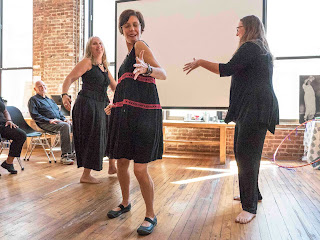 |
| LIGHT GETS IN with LEAH MANN. The Mask Center, Little 5 Points Community Center, October 2016. (photo by Ruth Schowalter). |
Ring
the bells that still ring.
Forget
your perfect offering.
There
is a crack in everything.
That's
how the light gets in.
-Leonard Cohen
Written by Ruth Schowalter, Certified InterPlay Leader
On Friday, October 21, metro-Atlanta
folks were invited to spend two hours with international performer and
InterPlayer Leah Mann
to explore the “cracks” in their lives—inside and out—and to examine “pathways
of light” coming through to heal those fissures.
Hosted by InterPlay
Atlanta at the Mask Center in the Little Five
Points Community Center, Leah used the container of InterPlay as a way to launch a group of a dozen
participants into investigations about their lives and the wider world in the
workshop, “Light Gets In.”
In
the first hour, Leah led us gently and incrementally in warming up our bodies
and voices. Along with using
the “primary colors” of movement—thrust, swing, hang, and
shape—we were offered the opportunity to reflect on our emotions and situations
in our lives associated with these movements. Leah explains, “I combined some
of the ideas of Julie Motz, reiki master and author, about where
emotions flow or are held in the body.”
Following
this deep investigation into our bodies and spirits through movement, we then
found ourselves making a community sound standing around in a circle, with some
participants creating new sounds while others became historians repeating
rhythms or words offered by others.
In
the second hour of our workshop, with thoroughly warmed up bodies and voices
and after connecting with one another, Leah guided us into making inquiries and
collecting data about ourselves, our communities, and the world on the
complicated theme of “systemic shatterings.” In word, sound, and movement, we
explored our “groan zones” and “shatter zones.” We created a “scar inventory”
and played around with “sitting in my discomfort.”
 |
| SHATTERINGS & THE CONCEPT OF "KITSUGI". In pairs, we told organic stories about things in our lives that remained broken or had been repaired (photo by Ruth Schowalter). |
 |
| SCAR INVENTORY. With a witness, each of us had an opportunity to dance with our scars (photo by Ruth Schowalter). |
 |
|
SITTING IN MY DISCOMFORT. Leah invited us to "sit in our discomfort," explaining that it is important to be patient and to be awake for the next right step as we awaken to systems in the world that are breaking down and need to be dismantled (photo by Ruth Schowalter).
|
During
our “babbling” or “short telling” sequence, many of us gratefully received
Leah’s offering of the concept of the Japanese
art form of “kitsugi” (mending pottery with gold) as metaphor for healing that
which has been broken. The broken vessel is not only stronger but also has more
value.
Two
hours were too short to travel this trajectory of “shatterings” in relationship
to our personal experiences and current events. I wonder what other discoveries
I would have made had we been able to spend a third hour together! What stories
might I have heard from other participants or would I have shared of my own.
Leah expressed her thoughts on this: “It was just two hours. I think a minimum
for this sort of exploration could be three hours or longer. A ‘walk about’ on
a theme like this could have taken more than an hour.”
 |
| LIGHT GETS IN PARTICIPANTS WITH LEAH MANN. (photo by anonymous workshop participant) |
There
is mystery in movement, voice, story, and shape and stillness. Leah Mann is a
magician, a genius, and a gentle guiding force—one who can create the container
for play, insight, and healing to occur. Thank you Leah for this offering to
the InterPlay Atlanta community and metro-Atlanta area. I hope you will return
and spend more time with us on this theme, “Light Gets In.” It is important
work!
“InterPlay has been a huge part of my personal development work as an activist,
artist and human being. The system is a powerful platform for deep inquiry.”
–Leah Mann
About Leah Mann: Leah lives
in Vashon, Washington, but has strong ties to Atlanta, having moved here after
her father retired from the Army. She returns regularly to visit her mother,
who lives in College Park and to continue her work as the co-founder and
artistic director emeritus of the urban outreach program, Moving in the Spirit.
Leah now co-directs Lelavision Physical Music. With her partner Ela Lamblin,
she tours internationally, performing a hybrid genre combining kinetic music
inventions animated through music and dance in simultaneity. She teaches
movement, rhythm and instrument making from ordinary objects with a wide
variety of populations from a base of improvisation informed primarily by the
InterPlay technique. Check out her website: www.lelavision.com
































